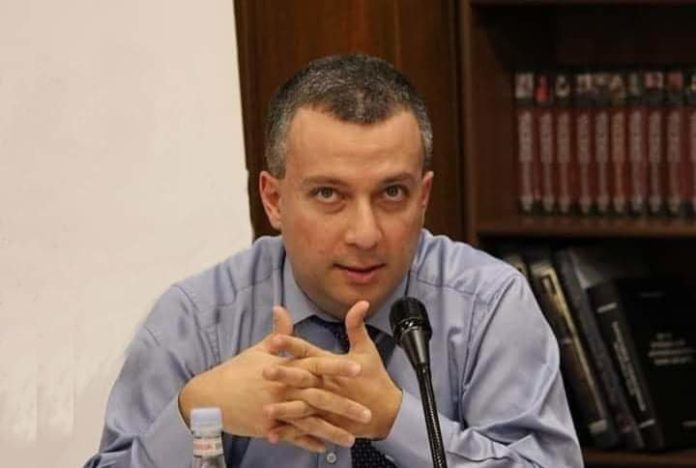By Benyamin Poghosyan Published in The Armenian Mirror Spectator
The most asked question after the military takeover of Nagorno-Karabakh by Azerbaijan perhaps is this: Why is there no peace agreement between Armenia and Azerbaijan? The status and future of Nagorno Karabakh have been the cornerstones of the conflict since the late 1980s. The sides’ positions were too far away from each other to give any hope for compromise. Armenians were sure that Nagorno-Karabakh could not be part of Azerbaijan, as Armenians could not live under Azerbaijani jurisdiction. Azerbaijanis were sure that Nagorno-Karabakh should be part of Azerbaijan.
The situation changed only in October 2022, when the Armenian prime minister signed a statement in Prague and recognized Nagorno-Karabakh as part of Azerbaijan. It seemed that the radical change in Armenia’s position would finally open the way for Armenia – Azerbaijan normalization. Armenia would accept that Nagorno-Karabakh is part of Azerbaijan, while Azerbaijan would provide security guarantees for the Nagorno-Karabakh Armenians. However, only the first part of the equation was actual. Armenia recognized Nagorno Karabakh as part of Azerbaijan and even dropped any demand for autonomy. On the other hand, Azerbaijan imposed a blockade on Nagorno Karabakh and, in September 2023, launched a military offensive, forcing the entire Armenian population of the region to leave their homeland.
Nevertheless, as more than one hundred thousand Armenians were entering Armenia, many in the international community hoped the era of peace would finally arrive, and their logic was clear. The issue of Nagorno Karabakh and the future of Armenians were the main obstacles to Armenia – Azerbaijan normalization. As the Nagorno Karabakh Republic was destroyed, nothing might prevent Armenia and Azerbaijan from signing a peace agreement. It will then pave the way for normalizing Armenia–Turkey relations and the South Caucasus’s geopolitics will be changed.
Everyone started to speak about an Armenia – Azerbaijan peace treaty by the end of 2023. It evoked a sense of déjà vu, as in autumn 2022, there were intense discussions about the possibility of signing the Armenia – Azerbaijan peace agreement by the end of 2022. However, in late September 2023, many were sure that nothing could prevent peace this time. However, October – November 2023 has changed everything. In early December 2023, no one spoke about a peace agreement by the end of 2023; even more, no one knew when and where Armenia – Azerbaijan negotiations might resume.
There is confusion in the West as people seek to understand what is going on. On the surface, the reason behind these developments is Azerbaijan’s rejection of the Western negotiation platforms. Suddenly, Azerbaijan understood that the EU and the US, as outside players, bring only chaos and instability to the South Caucasus. Simultaneously, Azerbaijan hints that the signature of a peace agreement in the West will irritate Russia and Iran, and Azerbaijan has no wish to worsen its relations with these powerful states, which will have significant influence in the region in the foreseeable future. Azerbaijan now offers to resume negotiations in Moscow or have direct talks, without any mediators, either in Georgia or near the Armenia – Azerbaijan border.
Armenia avoids the Russian platform, as Armenia–Russia relations are rapidly deteriorating, and Armenia does not want direct negotiations. Armenia needs guarantors which will prevent any violation of the peace agreement by Azerbaijan.
However, the differences about location are only the tip of the iceberg. The core reason for the sudden collapse of the negotiation process is that Azerbaijan is not interested in any peace agreement with Armenia, even one that will satisfy all its demands on enclaves and corridors. Since President Aliyev inherited power from his father in 2003, he used the Nagorno-Karabakh conflict, particularly the idea of bringing back Shushi, as a unifying idea to rally the Azerbaijani population around himself. The strategy was straightforward – there were many problems in Azerbaijan, from enormous inequality and rampant corruption to the lack of fundamental freedoms. However, society was asked to forget about them and rally behind the leader who promised to raise the Azerbaijani flag in Shushi. This promise seemed like a fantasy in 2003, but most of society accepted this deal.
Then, after 17 years, Azerbaijani troops entered Shushi. They raised a flag there, and in 2023, all Armenians were forced to leave Nagorno Karabakh. President Ilham Aliyev received a military parade in Stepanakert on the 20th anniversary of his first election as president. President Aliyev seems to have realized his promises and will forever be perceived as a national hero in Azerbaijan, securing his and his family’s position as rulers of Azerbaijan for decades.
However, as always, the medal has two sides. Many, if not all, in Azerbaijan perceive President Aliyev as a national hero. However, after the deal reached back in 2003 is fulfilled, sooner or later, people will start asking questions about inequality, rampant corruption, lack of fundamental freedoms, and other problems ravaging Azerbaijan.
To prevent these developments, President Aliyev needs a new unifying idea that will rally the population behind him, as the idea of raising the Azerbaijani flag in Shushi did in 2003, and which will make Azerbaijani society tolerate the multifaceted problems of current Azerbaijan. Azerbaijani leadership decided the new idea would be the vision of “Western Azerbaijan.” Currently, the idea lacks clarity – does it mean raising Azerbaijani flags in Armenian cities, including Yerevan, or it envisages the “peaceful return of Azerbaijanis into Armenia,” where they will live as Armenian citizens?
However, despite the lack of clarity on details, the grand scheme is there – Azerbaijani society should rally behind President Aliyev and his family in the next 20 years to realize another national dream, as they did in 2003 and realized their dreams of having Azerbaijani flags in Shushi and other cities of Nagorno Karabakh. Moreover, in this context, the peace agreement with Armenia will only hinder the process. Even the best peace agreement for Azerbaijan, which will give Azerbaijan so-called enclaves, establish direct land access with them, and create the “Zangezur corridor,” will kill “the dream of Western Azerbaijan.” Thus, Azerbaijan, or at least the current leadership, does not need a peace agreement with Armenia; even more, a peace agreement with Armenia may create significant problems for the leadership to secure its position for the next 20 years.












